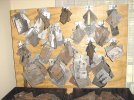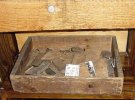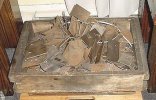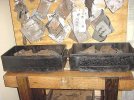- Joined
- Jan 21, 2001
- Messages
- 1,634
I realize that there is presently a thread on regarding displays however I did not want to hijack someone elses postings so I thought I would start this one.
Ok so lets say that you have a couple of tons of steel dies, tang stamps, jigging gauges ect that you picked up when your local knife factory closed. You risked life, limb, and hernia hauling it over a foggy mountain road with an old pickup truck and a trailer with no lights. Then once you get it home it sits for a couple of years under all the other items you dragged off that probably no one else in the world gives a damn about . No problem it is still in the same boxes that it sat in with the same dirt for the last 80 years anyway.
Now you start to think about how you might want to display some of this stuff if indeed anyone in the world ever might have an interest in seeing it.
This was my situation. You see some of the factors involved were first weight this stuff is solid steel and the quantity made for an amazing amount of poundage. Next there was space ( a very rare commodity in my house. ) .
These factors had kept this project on a back burner for quite a while. Then John stepped into the picture. John is one of the few friends I have who is still alive. He is 5 foot 6 and built like a 250 plus lb, fire plug. Every thing he builds is made the same way. He recently had a pig roast over at his house while there he showed me two cutting tables which he had made. He said he only needed one and to take the other if I wanted it. There it was the answer to my steel jig and gauge board. Like I said John tends to over build to the extreme. The center board is around 5 inchs thick. legs 4X4s He used nails instead of screws with a commercial air gun that shot 3 and one half inch nails straight in. John like myself prefers speed to being dainty. We have a lot in common main building criteria big, heavy, strong, to hell with neatness. One of the benefits of living alone ( or with two cats in my case ). Whatever strikes my fancy can become living room furniture. This thing alone is so heavy that it needs two people to move it. Once home I made my adaptations three quartet inch finished ply back board a 1000 lb dolly, stain, 4 coats of Poly ect. So this is my newest display. If you need the plans for it let me know it would go very nice in a high class impecable house the kind of thing most females would cherish as a family heirloom.
 LT PS I almost forgot why I feel these items are important to this history. George Schrade is often given credit for his innovations and inventions yet it was these little buggers that changed the face of the cutlery industry. Prior to there inception. Knife companies had a master cutler and apprentice system. Originally what this meant was that a master cutler made a half dozen styles of knives ( that he had made for 40 ty years) he would have an apprentice or two that would take over and make these same items when he died or retired. It gave the craftsmen quite a lot of leverage since if they asked for a raise and did not get it they could threaten to leave or start a new company ( which in fact they often did ). Waterville begat, New York Knife, begat Walden knife, begat Ellenville knife ect. All usually because of one spat or another.
LT PS I almost forgot why I feel these items are important to this history. George Schrade is often given credit for his innovations and inventions yet it was these little buggers that changed the face of the cutlery industry. Prior to there inception. Knife companies had a master cutler and apprentice system. Originally what this meant was that a master cutler made a half dozen styles of knives ( that he had made for 40 ty years) he would have an apprentice or two that would take over and make these same items when he died or retired. It gave the craftsmen quite a lot of leverage since if they asked for a raise and did not get it they could threaten to leave or start a new company ( which in fact they often did ). Waterville begat, New York Knife, begat Walden knife, begat Ellenville knife ect. All usually because of one spat or another.
George Schrade ended the tyranny of the master craftsman. He came up with these steel jiggings what this meant is that a fellow walking in off the street who might say look all I want is a job I have a wife and family. I will paint, sweep, clean the privvy or anything else to put bread on the table. Well then old George would hand him one of these jigs and say here is the finished part ( blade or whatever ) attached to this jig he would show him how to use it like grind here until the back fits the correct notch in the jig then turn it this way or that until when finished it looks like the pattern attached to the jig. In other words he showed him how to use the jig and make parts without apprenticing for 20 years. The beauty of it was that the following week when they had enough of those blades he could hand the new guy a different jig therefore eliminating down time while having a brand new employee making all of the knives he sold by simply knowing how to use a jig and gauge. You will notice that this ended people leaving to start new knife companies. Schrade once it adopted this manufacturing method had one of the best employee managment releationships of any similar company in fact they never even had a union. In 1904 this was one of the reasons Schrade left Walden knife (press button) and started Schrade with his brothers. It was only one of the innovations he wanted to try, there were others assembly new machinery and other various new methods still it was one of the most important and perhapes most overlooked. PPS those boxes on the stand are all originals from the factory. However I have no certificates to prove it.
Ok so lets say that you have a couple of tons of steel dies, tang stamps, jigging gauges ect that you picked up when your local knife factory closed. You risked life, limb, and hernia hauling it over a foggy mountain road with an old pickup truck and a trailer with no lights. Then once you get it home it sits for a couple of years under all the other items you dragged off that probably no one else in the world gives a damn about . No problem it is still in the same boxes that it sat in with the same dirt for the last 80 years anyway.
Now you start to think about how you might want to display some of this stuff if indeed anyone in the world ever might have an interest in seeing it.
This was my situation. You see some of the factors involved were first weight this stuff is solid steel and the quantity made for an amazing amount of poundage. Next there was space ( a very rare commodity in my house. ) .
These factors had kept this project on a back burner for quite a while. Then John stepped into the picture. John is one of the few friends I have who is still alive. He is 5 foot 6 and built like a 250 plus lb, fire plug. Every thing he builds is made the same way. He recently had a pig roast over at his house while there he showed me two cutting tables which he had made. He said he only needed one and to take the other if I wanted it. There it was the answer to my steel jig and gauge board. Like I said John tends to over build to the extreme. The center board is around 5 inchs thick. legs 4X4s He used nails instead of screws with a commercial air gun that shot 3 and one half inch nails straight in. John like myself prefers speed to being dainty. We have a lot in common main building criteria big, heavy, strong, to hell with neatness. One of the benefits of living alone ( or with two cats in my case ). Whatever strikes my fancy can become living room furniture. This thing alone is so heavy that it needs two people to move it. Once home I made my adaptations three quartet inch finished ply back board a 1000 lb dolly, stain, 4 coats of Poly ect. So this is my newest display. If you need the plans for it let me know it would go very nice in a high class impecable house the kind of thing most females would cherish as a family heirloom.

George Schrade ended the tyranny of the master craftsman. He came up with these steel jiggings what this meant is that a fellow walking in off the street who might say look all I want is a job I have a wife and family. I will paint, sweep, clean the privvy or anything else to put bread on the table. Well then old George would hand him one of these jigs and say here is the finished part ( blade or whatever ) attached to this jig he would show him how to use it like grind here until the back fits the correct notch in the jig then turn it this way or that until when finished it looks like the pattern attached to the jig. In other words he showed him how to use the jig and make parts without apprenticing for 20 years. The beauty of it was that the following week when they had enough of those blades he could hand the new guy a different jig therefore eliminating down time while having a brand new employee making all of the knives he sold by simply knowing how to use a jig and gauge. You will notice that this ended people leaving to start new knife companies. Schrade once it adopted this manufacturing method had one of the best employee managment releationships of any similar company in fact they never even had a union. In 1904 this was one of the reasons Schrade left Walden knife (press button) and started Schrade with his brothers. It was only one of the innovations he wanted to try, there were others assembly new machinery and other various new methods still it was one of the most important and perhapes most overlooked. PPS those boxes on the stand are all originals from the factory. However I have no certificates to prove it.





